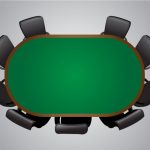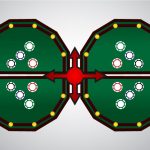“Don’t be a Poker Pansy.” Apparently you can’t make a post in the Beginner’s Forum without attaching some cheesy phrase to it. That’s probably because most beginners are slow thinkers and incapable of comprehending anything beyond basic ABC poker…
Ok, that’s not true. New players don’t need to be baby talked or otherwise have strategy presented to them in a patronizing manner. If you want to read a story then go find some Dr. Seuss. You can’t play winning poker over a significant amount against thinking opponents if you’re relying on charts, tables, graphs, recipes, cheat sheets, etc. So, if you want a cookbook, I’d suggest you then find your way to the kitchen instead of a poker table.
I’ve observed that the vast majority of information and strategy presented to beginners is in a “how to” format. How to play AJs from middle position. How to play a flopped set. How to tie your shoes. How to bake a cake…. I think the reason for this is that it is easy. Yes, it can be very effective as well. It is a shortsighted approach to the game though. It’s in essence a get rich quick scheme in that it offers the potential for immediate profits. Such strategies fail to maximize these profits though and are rarely successful beyond the lowest of limits. More damaging is that these strategies, although effective initially, hinder the long term development of a player. Many players that follow such advice have difficulty progressing to higher stakes. They’re rigid in their play and don’t find success against the thinking players that become more and more common as the stakes increase. They lack the understanding to recognize these changes and how to appropriately adapt to them. They find themselves caught in a cyclical up-down-up-down pattern as they try to move up in stakes. It’s a very frustrating experience and a major reason why many people quit playing.
New players need a strong foundation to build their game upon. For the sake of a player’s development, it’s not so important that they simply be told what to do. The crucial aspect is that they understand the reasoning behind their actions. This is the harder route to take. It requires more time and patience. Because of that, short term profit may be less. If you’re taking a long term approach to the game though, you’ll often find that after a slow initial start, the progression to higher stakes can be quite rapid.
If you make an active effort to really learn the game, you’ll also find it more enjoyable. When you first begin playing it’s often all about making money. Ok, that really doesn’t change as you become better and move up in stakes. What does happen though is that you’ll find the game to be more intellectually stimulating. Following charts and playing ABC poker becomes boring rather quickly. As you start to add additional levels of thinking, the game takes on an entirely different dynamic. It becomes a mental exercise. It becomes poker.
If you’re a new player and have any aspirations of playing beyond your current stakes, then I encourage you to be a student of the game. I encourage you to study poker theory, play, ask questions, play some more, discuss situations with other players, and then play even more. Poker is like anything else, you get what you put in.
* My intention is to provide information that is less “how to play” and more “how to think.” There is a lot of information about how they should be playing (ie. play aggressively), but little on the reasoning behind playing in such a manner. Using this approach, immediate results are of less concern than the long term development. The inherent problem with such an approach is that some of the information may not be fully understood and a lack of experience may cause it to be misapplied.
Although some of the concepts may have less importance at certain stakes, they’re certainly not irrelevant. I think it’s also important to remember that as one moves up in stakes, these concepts start to become increasingly more important. Regardless of a player’s skill level or the stakes they play, I believe that everyone should at least be aware of them. My ultimate goal is to help ease the transition as one moves up in stakes and to help a good framework for them to become competent, thinking players.
I’m not a theoretician, but I hope some of what I have to say may be of some benefit nonetheless. In addition to essays, I’ll also be posting hand histories that illustrate certain concepts. I will be discussing my thought process throughout these hands.
1 – Passive vs. Aggressive
Pas-sive, adj.: accepting or submitting without objection or resistance
You want my blind? Ok, you can have it. Please don’t take it again next time.
Ag-gres-sive, adj.: assertive, bold, and energetic.
Sorry sir, but you’re going to have to pay a lot more than that for my blind. You’re also going to have to think long and hard about it the next time you try stealing it.
Passive poker is weak poker. There are exceptions where playing passively may be correct (such as when trying to induce a bluff), but generally speaking, playing passively is incorrect. It is incorrect because poker is about maximizing your edge. Playing passively is typically less effective at doing this than playing aggressively.
How and why is playing passively a mistake? A passive player is going to lose against a skilled player that is playing aggressively, although their passive play may limit their loses to an extent. A passive player is very susceptible to being bluffed. A skilled player will notice and exploit this at every opportunity. A passive player does not bluff/steal enough themselves. They deny themselves profit by repeatedly passing up good opportunities to do so, and even when they do it’s not with near enough frequency to compensate for the losses on their bad hands, bad beats and times they fail to maximize their winners. A passive player gives their opponents too many free cards. They’re too worried about what hands they currently can or can’t beat that they allow opponents additional opportunities to draw out for free. Finally, the biggest mistake passive players make is that they fail to maximize the value of their winning hands. This should be self explanatory. If you’re not maximizing your winning hands, then you’re leaving money in your opponents’ stacks that should be in yours.
A passive player has to be content with winning small pots because playing passively relies on your opponents giving you money. Good luck finding opponents that will do this willingly. They’re either going to have to bluff it off to you or be totally incompetent to not realize when you wake up with a hand. Even when a passive player has a hand and someone attempts to bluff them, they typically still won’t make much money because the aggressive player will then shut down when met with resistance. Likewise, when a passive player suddenly becomes aggressive they’re going to have great difficulty getting action.
You don’t hear successful poker players being described as passive. They might play with a loose-aggressive (LAG) or tight-aggressive (TAG) style, but the common denominator is their aggression. Winning players understand the importance of aggression and that is why they make it a central part of their game.
How and why is playing aggressively better? The disadvantages of playing passively are counteracted with aggression. Getting bluffed? It is much harder to bluff an aggressive player when faced with the very real possibility of being either called or even raised. An aggressive player takes advantages of bluffing/stealing opportunities as well. The blinds they steal one orbit will offset the possibility of not getting a playable hand the next orbit. An aggressive player will take down orphan pots and the money in them because they know they don’t even need a hand to do so. An aggressive player does not give free cards very often. Draws come with a price and it’s the wrong price. Aggressive players also tend to get more free cards themselves. People will often check marginal hands they’d otherwise bet when an aggressive player is left to act behind them. People will also try to check-raise an aggressive player allowing the aggressive player to get a free card if they check behind. Lastly, a passive player’s biggest mistake is an aggressive player’s biggest asset, maximizing the money they win.
A passive player asks, “How much should I bet so I’ll get called?” An aggressive player asks, “How much should I bet to maximize my expectation?” A $10 bet that is called 100% of the time makes less money in the long run than a $20 bet that is called 60% of the time. It’s a balancing act, but most beginners fail to recognize that they can bet more than they do and still get called. By playing aggressively, a player increases their chances of value bets being called. An overbet by an aggressive player when they have a monster is also more likely to be called because of their history of repeated aggression. In other words, agressive players get action that passive players don’t.
Poker, especially NLHE, is a game where selective aggression is rewarded. Passive play seldom is rewarded.
Submit your review | |










